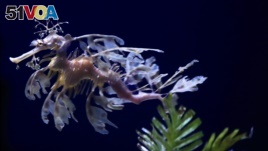29 May, 2019
At first, it seems to be a plant floating in the water. But look closer. What appear to be leaves on the plant are really parts of a sea creature.
With very small fins you can almost see through, the creature begins to move slowly through the water.
Little is known about sea dragons because there are only small numbers of them where they live off the coast of Australia. The sea dragon is related to the better-known sea horse.

In this Friday, May 17, 2019 photo, a sea dragon swims at the Birch Aquarium at the Scripps Institution of Oceanography at the University of California San Diego in San Diego. (AP Photo/Gregory Bull)
Warming oceans and pollution are threatening the world's sea dragons. So are people taking the creatures illegally for use in medicine or to keep around the home as pets.
An aquarium in the United States has built what is believed to be one of the world's largest habitats for sea dragons. The Birch Aquarium at Scripps is part of the Scripps Institution of Oceanography at the University of California in San Diego.
Aquarium officials opened a sea dragon exhibit earlier this month. They hope the show will lead to the leafy sea dragon reproducing for the first time in captivity.
Leslee Matsushige works for the aquarium. She says the sea dragon "look like something out of this world." The creatures have the ability to camouflage themselves. It is almost a trick because the sea dragon looks like a plant.
"When people see them move," she says, "you hear them say, ‘What? That's alive? Wow! That's crazy."
Scientists hope that when people come to see the captive sea dragons, they will read the signs next to the tanks where the creatures are kept. The signs give information about how to protect the sea dragons, and what can be done to make oceans healthier. This includes collecting wastes and stopping pollution from ending up in Earth's waterways.
Few aquariums have sea dragons, and there are only two kinds of them: the leafy and the weedy. Both are found only in remote areas off the southern and western coasts of Australia. Little is known about them because their populations are so small. But they only eat meat, and they have no teeth.
So far, only the weedy sea dragon, a bony fish that looks like a seaweed plant when floating, has given birth in captivity. And only a small number of times.
The Birch Aquarium's 5.5-meter-long tank has three leafy sea dragons — two males and one female — and 11 weedy sea dragons. The 20,062-liter tank is large, especially for the smaller leafy sea dragon. It grows to a length of only about 36 centimeters.
Scientists hope the large tanks will help the animals breed. Like seahorses, the male carries the young and gives birth. The aquarium is already seeing some mating behaviors, and they hope that eggs, and sea dragons, will follow soon.
I'm Anne Ball.
Julie Watson wrote this story for the Associated Press. Anne Ball adapted this story for VOA Learning English. George Grow was the editor.
_____________________________________________________________
Words in This Story
fin - n. a thin flat part that sticks out from the body of a fish and is used in moving or guiding the fish through water
pet – n. an animal (such as a dog, cat, bird, or fish) that people keep mainly for pleasure
aquarium – n. a glass or plastic container in which fish and other water animals and plants can live
habitat – n. the place or type of place where a plant or animal naturally or normally lives or grows
camouflage – v. to make something look like something else, sometimes to protect itself
weedy - adj. like a weed, a kind of plant
remote – adj. somewhere hard to get to
breed – v. to reproduce
We want to hear from you. Write to us in the Comments Section.